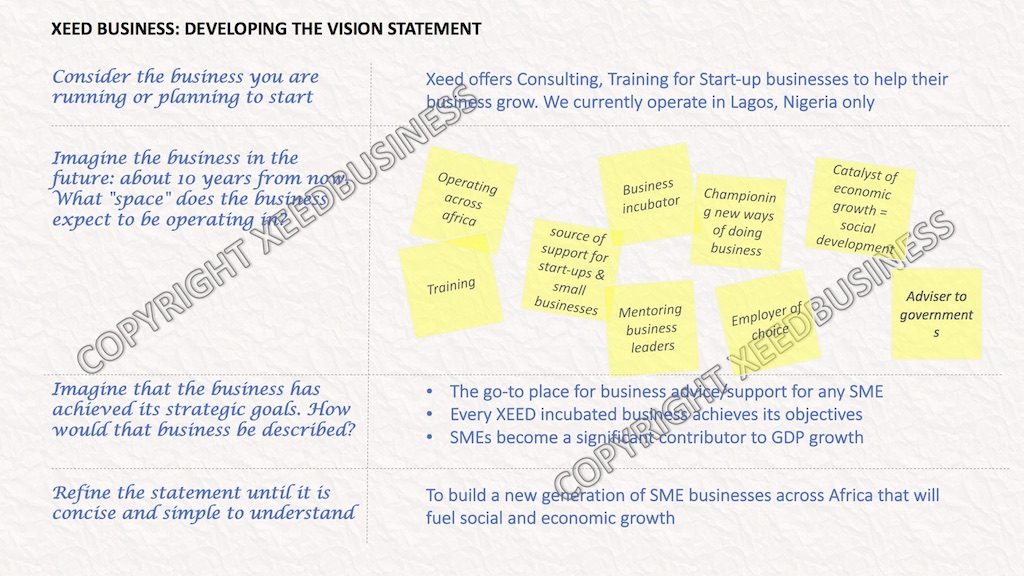
The first section of a business plan is the vision and mission statement. These statements describe the aimed "destination" of the business. It is important to start from this vantage point in order ensure that all activities carried out by the business drive towards this common goal.
In this article, the Vision and Mission statements are defined and we evaluate examples of statements from other organisations. Then, we provide guidelines that business leaders can use to develop the right mission and vision statements for their business.
The Vision Statement defined
A vision statement sets out the desired future for the company. It states the long-term position of the business; looking at a 5 to 10-year view. The vision statement has the following characteristics:
- It is aspirational and paints a picture that is far beyond the current status of the business
- It instils confidence and a sense of achievable ambition
- It describes a ‘space” that the organisation aims to operate in including its target segment, operating region and/or an industry sector
- It is concise and easy to understand
Taking the examples of Multichoice, the company which runs the satellite TV company DSTV and the Dangote group, one of the most diversified business conglomerates in Africa. The two Vision statements are shown below.

Multichoice's aspiration is “first choice and leading” and it aims to do this in Africa’s pay media industry sector. The aspiration of Dangote Group is to be a “world-class enterprise” which is quite an ambition for an African organisation.
Both statements define the position that these organisations aim to hold in future, not where they are performing today. The statements are also concise and easy to understand by their employees and by its external stakeholders.
The Mission Statement defined
A mission statement defines the company’s raison d’etre – why it exists. It includes what the company does and how it intends to achieve its objectives.
Continue with the two examples, DSTV’s mission is:
"To be constantly at the cutting edge of new technology that enables its subscribers to enjoy the very best home television experience."
Dangote’s mission is to:
“Touch the lives of people by providing their basic needs”
From these examples we can see that the mission statement describes how the vision will be achieved. Its key characteristics are:
- It is a short-to medium term focus for achieving its long-term objective
- It is practical and defines one specific strategy that the business will adopt to achieve its vision
- It is concise and easy to understand
DSTV aims to become the leading pay media destination through technological innovation, whilst Dangote Group wants to improve the standard of living for the general populace by providing their basic needs. These examples illustrate the close link between the vision and the mission statements.
Guidelines for developing the Vision and Mission statements
Having understood the Vision and Mission statements, here are some simple steps to help business leaders develop such statements for their business.
The Vision statement
- Consider the business you are running or planning to start
- Imagine the business in the future: about 10 years from now. What "space" does the business expect to be operating in?
- Imagine that the business has achieved its strategic goals
- How would that business be described?
- Refine the statement until it is concise and simple to understand
The Mission statement
- Re-iterate the business you are running today (or planning to start)
- Highlight elements of the business's product or service offering that are important to the customer e.g. as in the example of Multichoice, the customers may be looking to enjoy a better home television experience
- Explore ways in which the business can meet those needs e.g. through technological innovation
- Identify and focus on where the organisation can deliver a differentiated approach in the mid to long term
- Ensure that the final options supports the company's vision.
The process of developing the vision and mission statements should involve key internal stakeholders in the business and should be done in a group brainstorming session. Below is an example of the output of brainstorming session by XEED Business.

Why are these statements important?
Before concluding on this section, it is important to reiterate why these statements are important and how they impact the rest of the business plan. As discussed, Multichoice aims to be "Africa’s first choice and leading pay media destination anytime, anywhere". Everything the business does should drive towards this destination. For instance, Multichoice started producing its own content. The company has also developed technology to make its content available on mobile phones. These activities are in line with its vision. Assuming the company decides to sell television sets. Arguably, this is in line with its vision. However, if the company decides to open a grocery store, it will be difficult (maybe impossible) to identify how such a move supports its vision.
One the vision and mission statements are agreed by the business, they become is a critical yardstick for ensuring that all activities carried out by the organisation drive towards one common goal. Otherwise, the business will lose focus, expend resource and energy in multiple directions that lead nowhere.
Next, in this series on Business Planning we will looking at the external context.
Don’t miss any of the insights we will be sharing through this forum, sign-up for our newsletter today. Also, don't forget to add comments, questions or your feedback below.
Recent Posts
- CURIOSITY: THE FUEL THAT CHANGES THE WORLD 28/06/2022
- 6 LESSONS IN TURNING SETBACKS TO SUCCESSES 11/01/2022
- COVID19 – 5 STRATEGIES EVERY BUSINESS SHOULD EXPLORE 01/05/2020
- WHAT ENTREPRENEURS SAY THEY WANT vs. NEED . 22/02/2019
- 10 REASONS WHY AGRICULTURE IS IMPORTANT TO NIGERIA 11/02/2019
Sign-up for our newsletter
